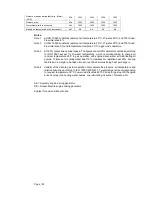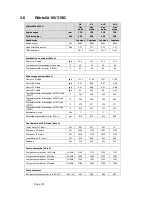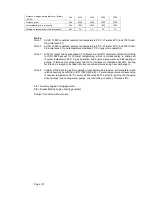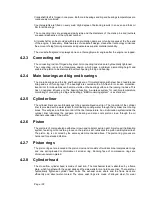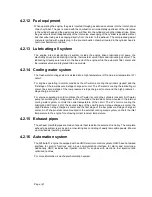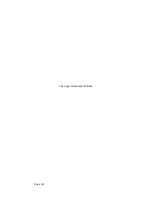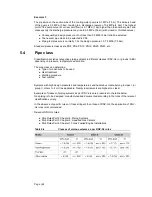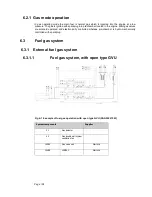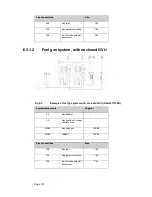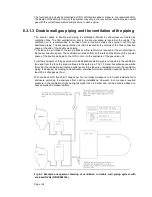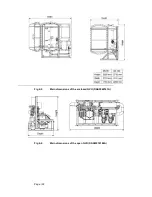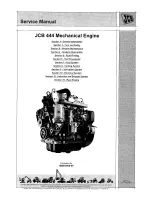
Page | 45
Table 5-1
Recommended maximum velocities on pump delivery side for guidance
Piping
Pipe material
Max velocity [m/s]
LNG Piping
Stainless steel
3
Fuel gas piping
Stainless steel / Carbon steel
20
Lubricating
oil
piping
Black steel
1.0
Fresh water piping
Black steel
1.5
Sea water piping
Galvanized steel
2.5
Aluminium brass
2.5
10/90 copper-nickel-iron
3.0
70/30 copper-nickel
4.5
Rubber lined pipes
4.5
NOTE
The diameter of gas fuel piping depends only on the allowed pressure loss in the
piping, which has to be calculated project specifically.
Compressed air pipe sizing has to be calculated project specifically. The pipe sizes may be chosen
on the basis of air velocity or pressure drop. In each pipeline case it is advised to check the pipe
sizes using both methods, this to ensure that the alternative limits are not being exceeded.
Pipeline sizing on air velocity:
For dry air, practical experience shows that reasonable velocities
are 25...30 m/s, but these should be regarded as the maximum above which noise and erosion will
take place, particularly if air is not dry. Even these velocities can be high in terms of their effect on
pressure drop. In longer supply lines, it is often necessary to restrict velocities to 15 m/s to limit the
pressure drop.
Pipeline sizing on pressure drop:
As a rule of thumb the pressure drop from the starting air vessel
to the inlet of the engine should be max. 0.1 MPa (1 bar) when the bottle pressure is 3 MPa (30
bar).
It is essential that the instrument air pressure, feeding to some critical control instrumentation, is
not allowed to fall below the nominal pressure stated in chapter "
Compressed air system
" due to
pressure drop in the pipeline.
5.2
Pressure class
The pressure class of the piping should be higher than or equal to the design pressure, which
should be higher than or equal to the highest operating (working) pressure. The highest operating
(working) pressure is equal to the setting of the safety valve in a system.
The pressure in the system can:
● Originate from a positive displacement pump
● Be a combination of the static pressure and the pressure on the highest point of the pump
curve for a centrifugal pump
● Rise in an isolated system if the liquid is heated
Within this publication there are tables attached to drawings, which specify pressure classes of
connections. The pressure class of a connection can be higher than the pressure class required
for the pipe.
Summary of Contents for 31SG
Page 1: ...Page 1 PRODUCT GUIDE W rtsil 31SG...
Page 4: ...Page 4 This page intentionally left blank...
Page 8: ...Page 8 This page intentionally left blank...
Page 14: ...Page 14 This page intentionally left blank...
Page 21: ...Page 21 This page intentionally left blank...
Page 43: ...Page 43 This page intentionally left blank...
Page 49: ...Page 49 Fig 5 1 Flexible hoses...
Page 52: ...Page 52 This page intentionally left blank...
Page 58: ...Page 58 Fig 6 4 Gas valve unit reference P I diagram DAAF051037D...
Page 60: ...Page 60 Fig 6 7 Gas valve unit P I diagram open type DAAF085795A...
Page 64: ...Page 64 Fig 7 2 Lubricating oil system single engine wet sump DAAF301501B...
Page 65: ...Page 65 Fig 7 3 Lubricating oil system Gas multiple engines wet sump DAAF301500A...
Page 72: ...Page 72 This page intentionally left blank...
Page 77: ...Page 77 Fig 9 1 Example diagram for multiple main engines DAAF301505A...
Page 87: ...Page 87 This page intentionally left blank...
Page 98: ...Page 98...
Page 109: ...Page 109 This page intentionally left blank...
Page 113: ...Page 113 This page intentionally left blank...
Page 119: ...Page 119 This page intentionally left blank...
Page 122: ...Page 122 18 4 1 Service space requirement 18 4 1 1 Service space requirement engine...
Page 124: ...Page 124 This page intentionally left blank...
Page 127: ...Page 127 This page intentionally left blank...
Page 129: ...Page 129 This page intentionally left blank...
Page 132: ...W rtsil 31SG Product Guide Page 132 21 2 Collection of drawing symbols used in drawings...




